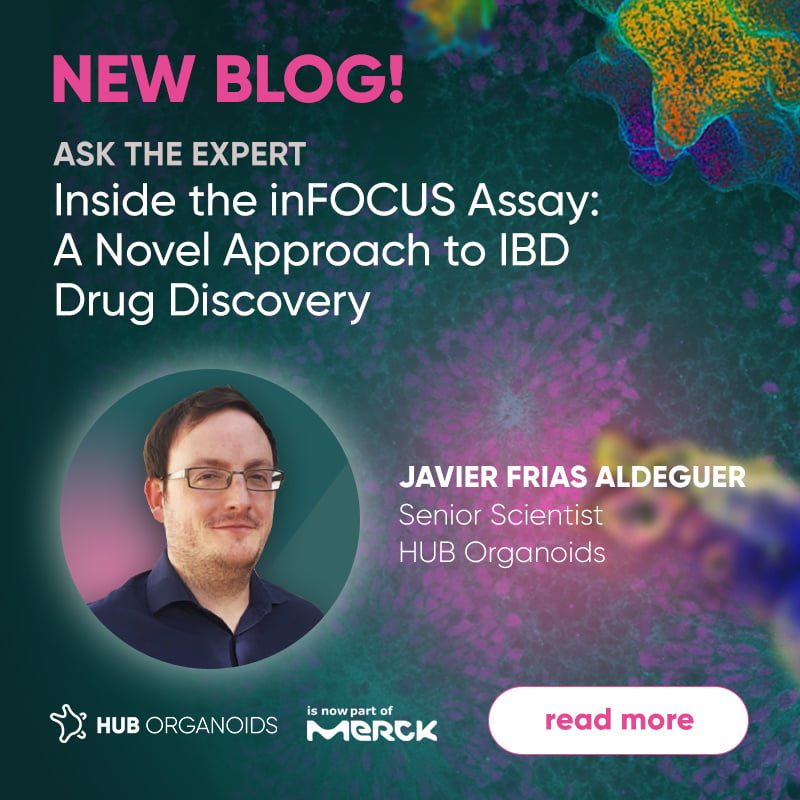Ask the experts - organoids for viral infection studies
Published by Federica Parisi, PhD on Aug 25, 2021
-1.png)
HUB and STEMCELL Technologies experts gathered virtually for a mini-symposium to discuss the development and characterization of organoids, how they are applied to studying organ development and disease, and the latest progess in understanding infectious diseases like COVID-19.
We asked the audience to submit their questions during the event and here is a chance to review the discussion on the applications of organoids to viral infection studies by Drs. Robert Vries, Sylvia Boj, and Ryan Conder.
ORGANOIDS IN VIRAL STUDIES
How are organoids being used to model viral infections?
Organoids have been used to study viral propagation, viral replication, and host responses to viral infection. Organoid cultures can serve as a platform to study and screen antiviral drugs and offer the opportunity to explore patient-specific responses to both infection and treatment.
For example, Lamers et al. (Science, 2020) recently published a proof-of-concept study, showing that the novel SARS-Coronavirus-2 can replicate in intestinal organoids. Other examples include the use of human airway organoids infected with respiratory syncytial virus to recapitulate central disease features (Sachs et al. 2019) and offer a model to study the infectivity of emerging influenza strains (Zhou et al. 2018).
Additionally, HUB and Erasmus University Medical Center have recently demonstarted how healthy liver organoids can be used to mimic Hepatitis B virus (HBV) infection and have found a previously unreported similarity in gene expression profiles between cirrhotic liver tissue from patients with chronic HBV infection and patient-derived liver cancer organoids.
What role have airway organoids played in modeling and understanding SARS-CoV-2 infection and pathogenesis?
Airway organoids are playing a major role in unveiling the mechanics of the host-virus interaction. Thanks to their ability to recapitulate the cellular diversity of the airway epithelium, airway organoids are serving as instrumental models for identifying COVID-19 therapeutics. Studies using airway organoids confirmed that SARS-CoV-2 infection is directly dependent on the expression of the ACE2 receptor at the cell surface of host cells, and that auxiliary cell membrane-bound proteases can facilitate viral entry. Additionally, infecting lung organoid cultures with SARS-CoV-2 has provided information on the preferred target cell type, revealing higher susceptibility to infection of ciliated cells compared to goblet cells. Lastly, using human pluripotent stem cell-derived organoids, researchers were able to show how SARS-CoV-2 infection induces chemokine production similar to what has been observed in COVID-19 patients.
What (if any) studies have been done on SARS-CoV-2 using kidney organoids? How might kidney organoids be co-cultured with SARS-CoV-2 and immune cells to model infection?
The full extent to which SARS-CoV-2 infects organs other than the lungs is still under investigation. Renal abnormalities have been observed in COVID-19 patients and podocytes and tubular epithelial cells have been shown to be susceptible to SARS-CoV-2 infection. The Penninger lab was among the first to use differentiated human kidney organoids to model SARS-CoV-2 infection in the kidney. However, further investigation will be required to better understand the role of the immune system in combating the disease. Understanding the factors that contribute to the considerable variability that has been observed between patients will be especially important in establishing effective treatment options. Co-culturing kidney organoids with allogeneic immune cells is presenting itself as a fruitful avenue of investigation for better understanding the pathophysiology of SARS-CoV-2 and for elucidating the factors contributing to the variability in different patient’s response to infection.
How are GI organoids (including organoid derived monolayers) being used to study bacterial adhesion in the GI tract? What protocols are available for applying this model in my own research?
The use of bacterial co-culture with intestinal organoids has dramatically increased given the importance of the gut microbiota on human health and disease. For example, bacterial-organoid co-cultures were used to identify the mutational signature caused by prolonged exposure to genotoxic E. coli. However, different experimental approaches and culture methods are needed depending on whether co-cultures are being maintained in the short- or long-term.
To model short-term interactions, organoid-derived monolayers provide a useful system as they enable easy access to the apical side of the epithelium. By culturing at the air-liquid interface, intestinal monolayers undergo further morphological changes that closely mimic in vivo intestine, providing a flexible platform for the investigation of bacterial pathogenesis (Moon et al. 2014, Pott et al. 2018). However, for long-term studies the 3D format enables epithelial cell proliferation in culture for longer periods of time. In this instance, bacteria are microinjected inside the organoid lumen (Pleguezuelos-Manzano et al. 2020) and the effects of bacterial infection are monitored over time.
How can organoids be used in a high-throughput manner for viral studies? What considerations need to be made for both organoid initiation and assay development in order to support the high-throughput application of airway organoids for studying SARS-CoV-2 morbidity and mortality?
One key consideration is whether the viral infection occurs via the apical or basolateral side of the cell. Viruses that require access to the apical side require micro-injection into the lumen of the organoids, or organoid culture as monolayers, which facilitates access to the apical surface. Viruses that infect via the basolateral side can employ either monolayers cultured on a Transwell® insert or organoids cultured in 3D. The experimental readout is another important consideration. For example, if measuring the effect of a virus or a potential treatment on the epithelium, cell death can be a useful output as organoids are susceptible to viral infection and recapitulate the response seen in vivo, which in most cases involves epithelial cell death. When the focus of the research is to understand immune cell contribution during viral infection, organoids can be co-cultured with immune cells, and immune cell activation can be used as an effective readout. However, organoids can only provide an understanding of the viral infection in a tissue-specific context and cannot inform on patient morbidity or mortality.



